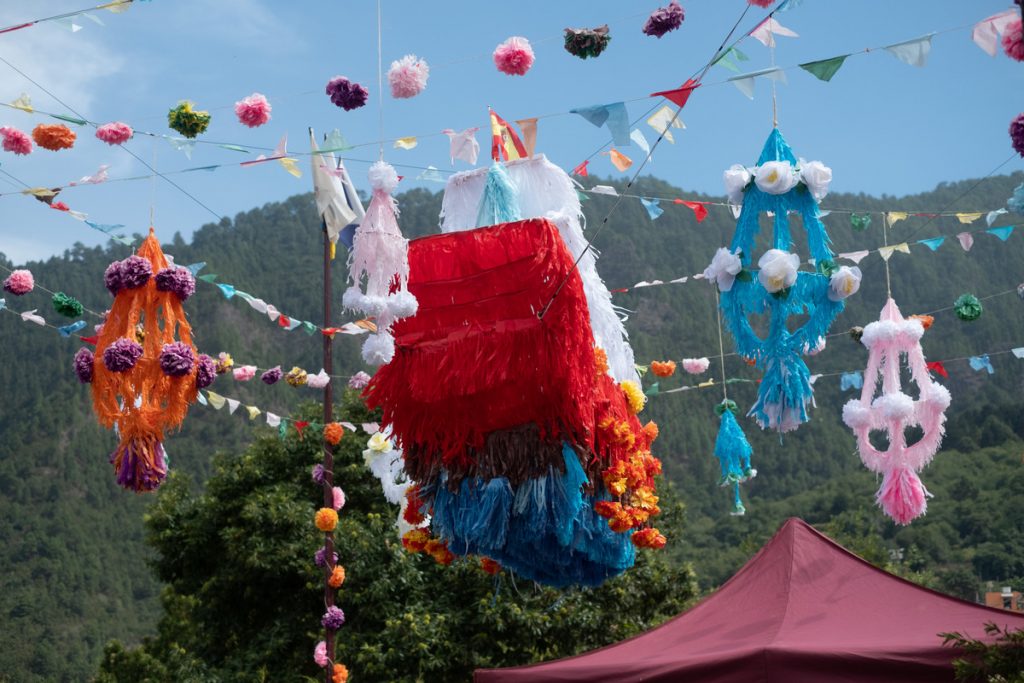
The enramadas or enrames is a very old tradition linked to the religion that consisted of decorating with branches of different species, such as beech, basil, rosemary or palms, the outskirts of the temples and the path through which the procession ran.
Over the years, the appearance of tissue paper or confetti added other decorative elements to these branches, such as flowers, garlands, arches, spiders or boats, supported on a wire or cane structure.
The enrame is not a custom of the Canary Islands but is also known and survives in other parts of the world, such as Mexico, where it is still kept for the Feast of All Saints, or the Day of the Dead, on November 1, given that in the Andean country the symbol of death does not reflect sadness but rather celebrates life.
In the islands, the confetti wrap was used to make for the holidays. In La Orotava, and in the specific case of the La Luz neighborhood, they date from the year 1620 and were linked to catechetical discourses, such as a ship with seven cannons, representing the seven sacraments, or a piñata in the shape of a dove, symbol of the Holy Spirit.
Neighbors met at night since the place was strictly agricultural and the work in the fields gave almost no margin to recreation, explains Pablo Torres Luis, a resident of the La Luz neighborhood, restorer, sculptor and curator and one of the people who collaborates in keeping alive a tradition associated with the Day of the Dead.
The festivals were changing, society was changing and the concept of parties as well. The disappearance of the enrame was gradual, until it was completely abandoned and replaced by other elements, such as the colored flags that came in drinks such as rum. “This also meant savings for party commissions, because they bought the drink and gave them the flags,” explains Pablo.

It was in 2006, with the decline of those parties that had been promoted from the 70s onwards, when the residents of La Luz and Las Candias returned to recover the tradition for the parties that are celebrated in the month of September and that they share the two neighborhoods, since they both belong to the same parish.
It is a very laborious craft that is also ephemeral, since elements such as temperature, sun or rain directly affect the paper that is discolored after being exposed for several days in the street.
The paper folds are bought, which is also very delicate despite the fact that it is no longer manufactured with the old silk cocoons – hence the origin of the name -, the templates are made and they are assembled according to the shape that you want to give it. .
Because this year’s Pinolere Handicraft Fair is dedicated to paper and cardboard, the Cultural Association proposed to the neighbors to make a sample in order to publicize the tradition of enrame to the whole public, in addition to giving them yesterday a deserved tribute for that recovery. It was one of the two recognition acts that took place within the framework of the event. The other went to the nougat Olivia Díaz Frías who is turning 80 and has been attending for more than 30 years.
There were about 15 people who spent a month working for the public to appreciate the work that the enrame carries. A large ship, flowers, spiders and flags of all colors have been hanging on the main stage of the venue since Friday in view of the attendees. Figures that do not go unnoticed due to their size and great color.
“It is an intangible heritage and therefore, if it is not done, it disappears. In the past it was common in many towns on the island, although now it seems like something original, ”says the restorer.
In the tribute, the manager of the Cultural Association, Jesús García, also underlined the important work of the neighbors, words with which the mayor of La Orotava, Francisco Linares, agreed, who announced that in 2022 the neighborhood festivals will take place. celebrate in person.
A break that the Pinolere Handicraft Fair also suffered, which today comes to an end and which can be visited until 8:00 p.m., after having opened its doors on Friday.















